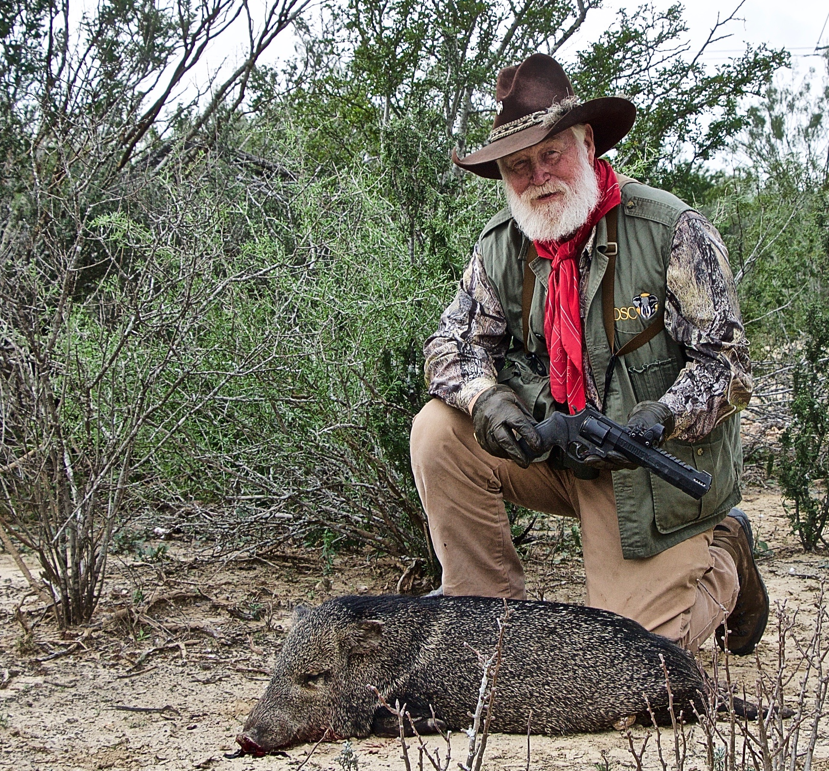“Looks like you’re perspiring a bit! How can you be doing that just sitting there, you’re not even blowing on a call and perspiring!” chided Blake Barnett.
As he spoke I took the red bandana from around my neck and started “mopping” my brow. By the time I was finished the neckerchief was sopping wet. As I rung it out, “Perspiration? You’re wrong I’m sweating, and sweating a bunch. Whose idea was it any way to try to call predators when it over a hundred degrees?” I responded.
“Your’s!” was his response!
“Oh!…guess you’re right….” I stood up after turning off our Bullet HP using my cell phone. “Let’s try a bit closer to the creek bottom. Got a feeling it’s probably cooler closer to the water. Maybe we can pick up another coyote there to go along with the three we shot earlier this morning. Work, work, work!”

After tucking our Nature Blinds Stalking Shield under our arms we walked to where our call was set up, picked it up, removed the flag decoy and the screwed in spike on the bottom of the unit, put them in their place in the call’s bullet shape, closed the Bullet HP, and started walking toward the distant creek bottom. As we walked Mike Snyder who had been sitting on the back side of a small rise watching the opposite direction Blake and I watched, joined us.
If I “perspired” while sitting in the shade waiting for coyotes or a bobcat to respond to the sounds of our dying cottontail call, now sweat poured out of me. The temperature was at least a couple of degrees north of the century mark and the humidity was nearly the same! It was pretty close to miserable. But we were not about to quit hunting.
Close to the creek the wind direction changed. I set the Convergent Hunting Solutions call up in a small low-grass opening. Blake and I moved up wind about 40 yards there set up our Stalking Shields as ground blinds where we had shooting lanes to our immediate left and right, as well quartering between both sides and the call. We could also see beyond the Bullet HP. Mike set up once again behind us watching upwind, just in case a critter approached from that direction. That way if any predator approached regardless of direction one of us would see it.
Before turning the call on, with my cell phone, we made certain our Rugers were again properly loaded. Blake was shooting his .308 Win Ruger American Ranch rile and I was carrying a Ruger .375 Ruger Guide Rifle shooting Hornady ammo, American Whitetail in Blake’s case and 300-grain DGX in mine. Mike was using the same rifle/ammo combination as I. Before you say that might be a bit big for coyotes or bobcats, I’ll tell you we were hunting in an area where there were a considerable number of wild hogs. I know .223s, 6.5 Creedmoors and the like all will take not only coyotes but also sizeable hogs. However, I personally like using larger caliber guns, even when hunting what some might consider fragile or lesser game. I’ve shot coyotes with .458s, .405 Winchesters and other large calibers and rounds, and I have never felt over-gunned. If anything, hunting predators with those larger rounds help me gain great confidence in my abilities with those bigger guns when I hunt game most considerable suitable for such rounds.
The purpose for hunting middle summer was two fold. One of course we enjoy calling critters. Secondly we hoped to reduce the number of bobcats and coyotes on the property, as well as feral hog population. This in an effort to help increase whitetail deer fawn survival. In the area of South Texas we were hunting fawns start “dropping” the first couple of weeks of July. We hoped to take as many individual predators from the area as possible just before fawning season.
There is no doubt coyotes and bobcats kill and eat whitetail fawns. But you may now realize that feral hogs, especially bigger sows and boars also kill and eat fawns.

We hoped to remove as many predators as possible, just before fawns were being born. Normally for the first week of their life fawns will lie exceedingly still and do not move when a predator approaches. But once they are about two weeks of age, they have a tendency to jump and run when predators approach. This is when most predation occurs.
One of the great things about Convergent Hunting Solutions’ Bullet HP electronic game calls is that they come with a considerable number of “sounds” that attract predators. Other “calling sounds” can easily be added. There are sounds that not only attract coyotes and bobcats, but wild hogs as well and even a rattling sequence I did with Rattling Forks to attract whitetails, as well as grunts and snort wheezes. And interestingly when not using it to call up critters you can connect to you Itunes and it serves as a fabulous “speaker”!
In years past before I had my Bullet HP, I often called predators during the heat of summer. Back then I used a mouth blown call, that I tuned to sound like a fawn in distress. Such “calls” are also available through Convergent Hunting Solutions.
One of the things I pay attention to, regardless of what time of the year I call is major and minor feeding periods, found on animal activity charts. I’ve discussed this topic with numerous serious predator callers. Some swear by the activity charts and others simply dismiss them. I tend to pay attention to them because when hunting whitetail deer, I have generally seen considerable movement when those charts suggested major and minor feeding periods. I have also had better response to calling predators during these times. But then it may simply be I have called more during those times, day and night, hot or cold, than during non-suggested (by the activity charts) peak movement or feeding times.
I’m always open to learning! Last year I got to spend time with Byron South, one of the best predator callers in the world. Byron has called in African lions, leopards and other critters in Africa, as well as bear, cougar, coyotes, bobcats, and foxes here in North America, not to mention wild hogs and javelina as well as elk and deer among other critters. One of the things I watched Byron do was when nothing responded to his initial offerings was to switch to another call; say rabbit to bird or bird to rabbit, or even wild hog sounds. In doing so he called in critters!
I had hardly turned on the Bullet from my cell phone via Bluetooth, when I heard Mike whisper, “He’s coming!”
I dared not move.
Less than twenty seconds later I heard Mike shoot and then softly say, “He’s down!”.
I kept the call “playing” hoping another coyote would respond. After another ten minutes I turned it off, but then we sat without moving for another five minutes in case there might be a “late responder”.
When nothing else came in we got and walked to the downed coyote, which upon closer inspection turned out to be an ancient male; teeth worn down almost to his gum.
Mission one accomplished.
About thirty minutes later we were in another location, Bullet HP set up. I turned on the call……
Larry Weishuhn is a proud life member of DSC and cohost of DSC’s “Trailing the Hunter’s Moon.” Be on the lookout for a blog from Larry again soon!



